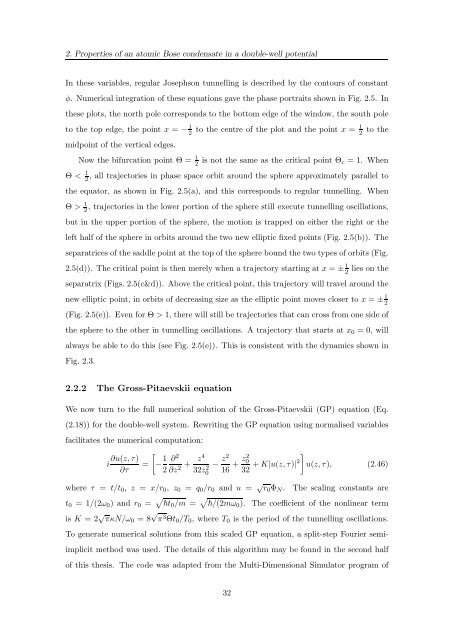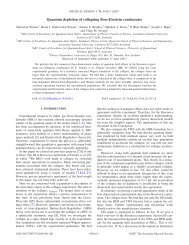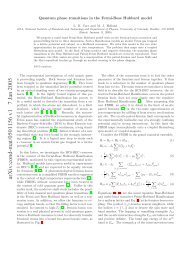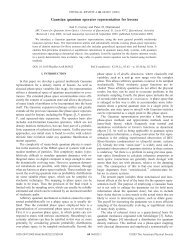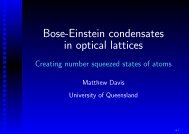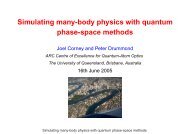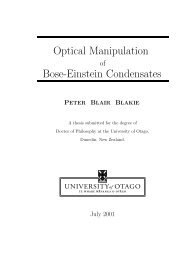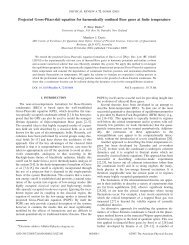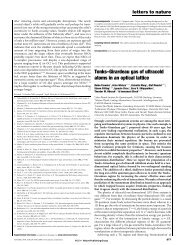Open Quantum Dynamics of Mesoscopic Bose-Einstein ... - Physics
Open Quantum Dynamics of Mesoscopic Bose-Einstein ... - Physics
Open Quantum Dynamics of Mesoscopic Bose-Einstein ... - Physics
Create successful ePaper yourself
Turn your PDF publications into a flip-book with our unique Google optimized e-Paper software.
2. Properties <strong>of</strong> an atomic <strong>Bose</strong> condensate in a double-well potentialIn these variables, regular Josephson tunnelling is described by the contours <strong>of</strong> constantφ. Numerical integration <strong>of</strong> these equations gave the phase portraits shown in Fig. 2.5. Inthese plots, the north pole corresponds to the bottom edge <strong>of</strong> the window, the south poleto the top edge, the point x = − 1 2 to the centre <strong>of</strong> the plot and the point x = 1 2to themidpoint <strong>of</strong> the vertical edges.Now the bifurcation point Θ = 1 2 is not the same as the critical point Θ c =1. WhenΘ < 1 2, all trajectories in phase space orbit around the sphere approximately parallel tothe equator, as shown in Fig. 2.5(a), and this corresponds to regular tunnelling. WhenΘ > 1 2, trajectories in the lower portion <strong>of</strong> the sphere still execute tunnelling oscillations,but in the upper portion <strong>of</strong> the sphere, the motion is trapped on either the right or theleft half <strong>of</strong> the sphere in orbits around the two new elliptic fixed points (Fig. 2.5(b)). Theseparatrices <strong>of</strong> the saddle point at the top <strong>of</strong> the sphere bound the two types <strong>of</strong> orbits (Fig.2.5(d)). The critical point is then merely when a trajectory starting at x = ± 1 2lies on theseparatrix (Figs. 2.5(c&d)). Above the critical point, this trajectory will travel around thenew elliptic point, in orbits <strong>of</strong> decreasing size as the elliptic point moves closer to x = ± 1 2(Fig. 2.5(e)). Even for Θ > 1, there will still be trajectories that can cross from one side <strong>of</strong>the sphere to the other in tunnelling oscillations. A trajectory that starts at x 0 = 0, willalways be able to do this (see Fig. 2.5(e)). This is consistent with the dynamics shown inFig. 2.3.2.2.2 The Gross-Pitaevskii equationWe now turn to the full numerical solution <strong>of</strong> the Gross-Pitaevskii (GP) equation (Eq.(2.18)) for the double-well system. Rewriting the GP equation using normalised variablesfacilitates the numerical computation:i ∂u(z,τ)∂τ[= − 1 ∂ 22 ∂z 2 +z432z02− z216 + z2 032 + K|u(z,τ)|2 ]u(z,τ), (2.46)where τ = t/t 0 , z = x/r 0 , z 0 = q 0 /r 0 and u = √ r 0 Φ N . The scaling constants aret 0 =1/(2ω 0 )andr 0 = √ t 0 /m = √ /(2mω 0 ). The coefficient <strong>of</strong> the nonlinear termis K =2 √ πκN/ω 0 =8 √ π 3 Θt 0 /T 0 ,whereT 0 is the period <strong>of</strong> the tunnelling oscillations.To generate numerical solutions from this scaled GP equation, a split-step Fourier semiimplicitmethod was used. The details <strong>of</strong> this algorithm may be found in the second half<strong>of</strong> this thesis. The code was adapted from the Multi-Dimensional Simulator program <strong>of</strong>32


